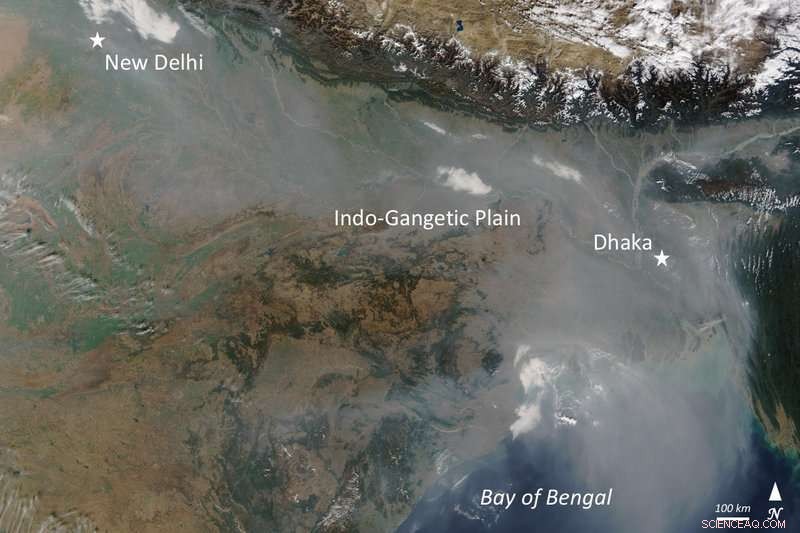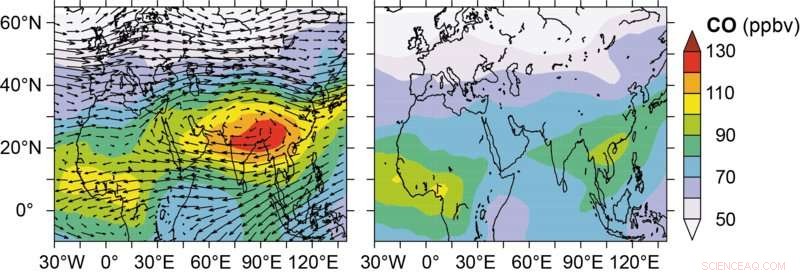
Una enorme nube de contaminación sobre el sur de Asia:la nube marrón atmosférica se crea durante los meses de invierno cada año por la combustión de biomasa y combustibles fósiles. Crédito:NASA, Jeff Schmaltz, Respuesta rápida LANCE / EOSDIS
El mismo fenómeno se repite todos los años. Durante la estación seca, en invierno, La quema de combustibles fósiles y biomasa en el sur de Asia crea una enorme neblina de contaminación:la nube marrón atmosférica. Un equipo internacional de científicos dirigido por el Instituto Max Planck de Química ha aclarado cómo y por qué desaparece tan pronto como comienza la temporada de lluvias en primavera. El resultado es que las corrientes ascendentes de tormentas los rayos y las reacciones químicas mejoran el poder de autolimpieza de la atmósfera, permitiendo que los contaminantes atmosféricos se eliminen eficazmente del aire. Sin embargo, los contaminantes que no se eliminan son transportados a la troposfera superior por el monzón y luego se diseminan por todo el mundo.
Ningún fenómeno meteorológico define el sur de Asia tanto como el monzón:este enorme sistema de circulación conduce a la sequedad en invierno pero trae intensas precipitaciones en verano. El monzón de verano se crea por el calentamiento de las masas de aire sobre el subcontinente indio y el aire cálido que se eleva. Como resultado, El aire húmedo del océano entra y fluye sobre la tierra hacia el Himalaya. Las nubes de tormenta profunda producen lluvia sobre la región durante meses, garantizar el abastecimiento de agua y salvaguardar las cosechas.
Los investigadores atmosféricos han sospechado durante mucho tiempo que las masas de aire ascendentes también transportan la contaminación a la atmósfera, incluso por encima de las nubes de lluvia. "Anticipamos que los contaminantes gaseosos y particulados se transfieren a un anticiclón, una enorme circulación de vientos en el sentido de las agujas del reloj, que se forma sobre las nubes sobre el sur de Asia como resultado de la convección de la tormenta, "dice Jos Lelieveld, Director del Instituto Max Planck de Química. Geográficamente los países de Bután, Nepal, Myanmar, Bangladesh, Tíbet, India, Sri Lanka, Pakistán y Afganistán son parte del sur de Asia. En esta región, Las emisiones de óxido de nitrógeno y dióxido de azufre por la quema de carbón y otros combustibles fósiles han aumentado en un cincuenta por ciento durante la última década. Sin embargo, la nube de contaminación también es alimentada por otras fuentes, en particular, la combustión de biomasa por parte de la gran población de la región.
El monzón transporta los contaminantes atmosféricos y los elimina
Una elaborada expedición con el avión de investigación HALO ha proporcionado pruebas de que el monzón del sur de Asia transporta contaminantes a través de la capa de nubes tan alto como la estratosfera:en 2015, el Instituto Max Planck de Química, junto con colegas del Forschungszentrum Jülich, el Instituto de Tecnología de Karlsruhe y el Centro Aeroespacial Alemán (DLR), lanzó la misión "Observaciones del mecanismo de oxidación" (OMO). "Nuestros vuelos de investigación revelaron que el monzón también elimina eficazmente los contaminantes de la atmósfera, "dijo el líder de la expedición Lelieveld. Los contaminantes se transportan a lo alto desde la superficie y se convierten rápidamente en compuestos que se eliminan más fácilmente con la lluvia.
El estudio del equipo científico descubrió así la virtud del monzón pero también su desventaja:una gran proporción de los contaminantes del sur de Asia se mueve por encima de las nubes monzónicas hacia el anticiclón. Allí se acumulan y luego se distribuyen por todo el mundo. Por ejemplo, casi el diez por ciento de las emisiones de dióxido de azufre del sur de Asia llega a la estratosfera, lo que a su vez tiene efectos sobre el clima y la capa de ozono. Por lo tanto, el monzón no solo representa un tipo de lavadora eficiente de contaminantes, pero simultáneamente contribuye a la contaminación atmosférica global.
HALO revela las fuentes de contaminación atmosférica y los procesos de degradación
Los científicos lograron estos hallazgos a partir de mediciones en el anticiclón:en julio y agosto volaron hasta 15 kilómetros hacia la salida del monzón, entre el Mediterráneo oriental y el Océano Índico, y analizó la composición de la atmósfera con el avión de investigación HALO. Pasaron por regiones del Medio Oriente, el Mediterráneo y el norte de África para investigar la extensión del fenómeno.

Los resultados del modelado ilustran la contaminación atmosférica en el sur de Asia. The left figure shows carbon monoxide emissions (CO) at an altitude of 12 to 17 kilometres, on the right is the same visualization but without emissions from South Asia. The figure on the left also shows the winds over the region, clearly revealing the anticyclone created by the monsoon. Credit:MPI for Chemistry
During the survey flights, they identified numerous chemical compounds in order to understand the sources of atmospheric pollution and the chemical processes in the atmosphere:sulphur dioxide and nitrogen oxides, ozono, aerosoles, chlorine-containing molecules, hydrocarbons and their degradation products.
More carbon monoxide and sulphur dioxide, but also more hydroxyl
Por ejemplo, the measurement flights revealed that carbon monoxide and sulphur dioxide concentrations within the anticyclone were significantly increased compared to outside. "The large amounts of sulphur dioxide originate from combustion processes by human activities and are much higher than natural background concentrations, " says atmospheric researcher Hans Schlager of the DLR. This, Sucesivamente, means that a substantial proportion of atmospheric pollution is transported to altitudes up to 15 kilometres. Además, the researchers were able to demonstrate that India represents a significant source of pollutants. It was previously assumed that much of the emissions come from China, because the monsoon's area of influence extends as far as East Asia.
"We also analysed the levels of hydroxyl radicals and found significantly higher concentrations within the anticyclone than outside it, " relates Max Planck researcher Hartwig Harder, who was present during the entire expedition. The hydroxyl molecule (OH) is better known as the atmospheric cleansing agent because it is highly reactive and efficiently oxidizes pollutants. Chemically, this has two effects:on the one hand, their solubility and thus their ability to lock on to existing airborne particles change, making them easier to wash out of the atmosphere by precipitation. Por otra parte, the oxidized molecules can combine to form new aerosols. Because the anticyclone expands widely and disperses the particles, this effect can impact the global climate.
More atmospheric cleaners thanks to lightning
The atmospheric cleanser OH primarily forms when ozone and water are broken down by sunlight. Once the radical has reacted with pollutants, it is generally lost. Sin embargo, if nitrogen oxides are present, it is recycled and can purify repeatedly, explains the atmospheric chemist Andreas Hofzumahaus of Forschungszentrum Jülich. Nitrogen oxides are formed not only by the combustion of diesel fuel, but also by lightning in the atmosphere. Because lightning frequently occurs during monsoon thunderstorms, the self-cleaning power at 15 kilometres altitude is maintained despite the atmospheric pollution. Según los científicos, even much more OH is recycled than is primarily formed.
Esto significa, luego, that the monsoon weather phenomenon not only pumps pollutants high into the atmosphere, but simultaneously provides a cleaning mechanism to remove some of those pollutants again.
This explanation was confirmed by the results of an established numerical model system, which computes the chemical processes in the atmosphere globally. Based on this model, it is possible to determine, entre otras cosas, the concentrations of individual chemical compounds such as carbon monoxide, dióxido de azufre, hydrocarbons, nitrogen oxides and those of the OH radical – verified based on the measurements. The OH decreases by a factor of two to three if the scientists do not take into account the nitrogen oxides produced by lightning in the model.
Because it can be assumed that pollutant emissions in the region will continue to increase in future years, the researchers headed by Jos Lelieveld are interested in how the two faces of the Janus-headed South Asian monsoon will develop in the future:Will the cleaning and transport mechanism continue to exist side by side or will they be tilted in one direction or the other?